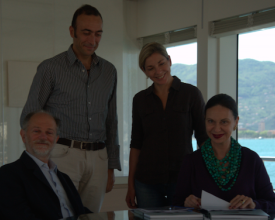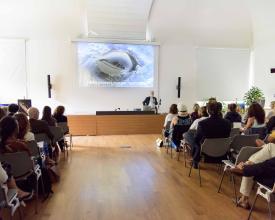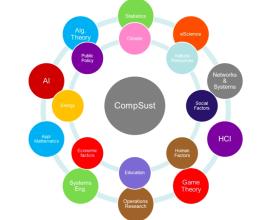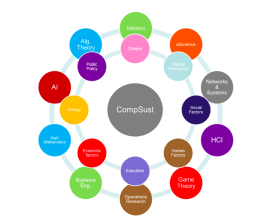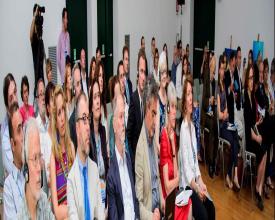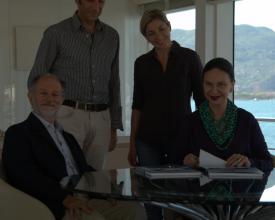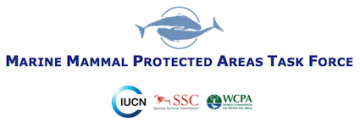
Waterevolution : une approche intégrée de la durabilité des grappes d'entreprises maritimes

Le modèle Waterevolution développe des partenariats stratégiques entre les entreprises du secteur maritime et la conservation marine. Il est basé sur la durabilité informatique et permet une réduction substantielle de l'empreinte environnementale et énergétique de l'industrie grâce à l'optimisation du processus de production. La mise en œuvre de ce modèle se traduit également par d'importantes économies, dont une partie est réinvestie dans des programmes de conservation marine, par exemple la planification et le financement d'aires marines protégées.
Contexte
Défis à relever
Mise en œuvre de partenariats innovants, financement de la conservation, réduction de l'empreinte de l'industrie Historiquement, l'industrie de la construction navale a souffert de l'absence de règles mondiales, retardant ainsi la confrontation du secteur avec les défis environnementaux, mais les opérations de yachting ont une empreinte environnementale importante. Le financement de la conservation marine est insuffisant ; par exemple, le sanctuaire Pelagos (la plus grande AMP de la Méditerranée) ne reçoit pas suffisamment de fonds pour assurer sa gestion efficace.
Emplacement
Traiter
Résumé du processus
Waterevolution est un modèle complet, fondé sur des preuves, qui implique une approche de gestion durable de l'entreprise pour réduire l'empreinte environnementale, qui génère un financement structurel pour soutenir les projets de science et de conservation marines et facilite l'engagement de l'industrie en faveur de la responsabilité des océans. Le modèle a été développé par l'Institut Eulabor en partenariat avec l'Université de Bologne et a ensuite été testé au sein du chantier naval italien de super yachts VSY. Le processus de production de VSY a été optimisé grâce à la mise en œuvre de l'outil informatique de durabilité. Le processus d'optimisation s'est traduit par une réduction significative de l'empreinte environnementale du chantier naval et, dans le même temps, a permis de réaliser des économies financières. Un pourcentage de ces économies a été investi pour soutenir des projets de conservation marine par plusieurs organisations, notamment : la recherche de l'Institut de recherche Tethys sur le sanctuaire Pelagos ; le travail de planification stratégique du groupe de travail WCPA-Marine de l'UICN sur les zones importantes pour les mammifères marins (IMMA) ; ainsi que plusieurs activités de conservation marine et de sensibilisation, des campagnes de communication pour la durabilité des océans et une initiative de renforcement des capacités pour les zones marines protégées italiennes.
Blocs de construction
Durabilité informatique
La durabilité informatique est un outil interdisciplinaire qui intègre des techniques issues de l'informatique, de la science de l'information, de la recherche opérationnelle, des mathématiques appliquées et des statistiques afin d'équilibrer les besoins environnementaux, économiques et sociétaux en vue d'un développement durable. Cet outil applique une approche "du berceau au berceau" aux chaînes de production et aux produits, en étendant le système à l'évaluation de l'ensemble du cycle de vie du navire (construction, transport, démantèlement) et en permettant une réduction substantielle de l'empreinte environnementale et énergétique d'une entreprise donnée en tenant compte de son coût financier et de son impact sur l'énergie et l'environnement. La durabilité computationnelle permet à l'entreprise de décomposer chaque étape du processus de production - l'ensemble du cycle de vie d'un produit jusqu'à son recyclage - et d'évaluer les éléments de durabilité à chaque étape en mesurant les indicateurs de coût-bénéfice, notamment : - Aider les concepteurs de yachts à l'aide de la modélisation mathématique pour définir, comparer et évaluer des solutions alternatives à toutes les étapes de la conception et de la production d'un yacht - Évaluer la comptabilité des matériaux et un certain nombre d'indicateurs environnementaux tout au long du processus.
Facteurs favorables
- Volonté des entreprises de reconditionner leur cœur de métier pour adopter l'efficacité énergétique et l'efficacité des ressources
- Favoriser les modèles économiques et technologiques qui permettent d'optimiser les processus industriels tout en réduisant l'impact sur l'environnement.
- Adoption d'une approche multidisciplinaire et holistique et mise en œuvre d'une perspective "du berceau au berceau" englobant l'ensemble du cycle de vie du navire (construction, transport, démantèlement).
Leçon apprise
Aider les concepteurs de yachts à définir, comparer et évaluer des solutions alternatives et des concepts de yachts, les guider à toutes les étapes de la conception du yacht en proposant des alternatives et en évaluant la comptabilité des matériaux et des activités ainsi qu'un certain nombre d'indicateurs environnementaux tout au long du processus. Développer une modélisation mathématique qui fournisse un support scientifique pour mesurer, définir et comparer des processus alternatifs et utiliser des modèles matriciels reliant les activités aux impacts environnementaux et des modèles matriciels reliant les activités aux coûts/bénéfices économiques. Tout au long du processus, le modèle doit également tenir compte de la consommation d'énergie, de la consommation d'eau, des émissions de CO2 et des matières premières utilisées.
Ressources
Plate-forme intersectorielle pour la conservation du milieu marin
Pour permettre un véritable engagement en faveur de la responsabilité des océans, un accord stratégique sur le milieu marin a été conclu entre les industries et les organismes de protection de la nature. Il comprend une plateforme commune destinée à faciliter la discussion et à sensibiliser aux problèmes des océans, tout en mettant en évidence les solutions réalisables grâce à un effort collectif. La mise en place de cette plateforme a été rendue possible grâce à de nombreux événements organisés pour faciliter le dialogue entre les différents acteurs de la protection de l'environnement, les industries et les institutions politiques. La question principale qui a été soulignée lors de ces événements était le fait que des mesures audacieuses et transformatrices sont nécessaires de toute urgence pour mettre le monde sur une voie durable et résiliente et que ces mesures ne sont réalisables que par une collaboration significative pour prendre des décisions informées et coordonnées pour l'avenir de l'océan et, par conséquent, pour notre propre avenir. En outre, la sensibilisation accrue au changement climatique et aux questions environnementales représente une excellente occasion pour le secteur d'adopter de manière proactive des pratiques durables, plutôt que d'être contraint de les adopter dans un avenir proche, tout en réinvestissant directement dans la conservation du milieu marin.
Facteurs favorables
- Développement d'une plateforme de communication intersectorielle spécifique pour permettre la compréhension du modèle par des parties ayant des antécédents et des intérêts différents.
- Adoption d'une approche collaborative
- Sensibilisation accrue au changement climatique et aux questions environnementales, au niveau mondial et de la part du secteur de la navigation de plaisance.
Leçon apprise
Afin de s'engager activement et d'agir collectivement en faveur d'approches et de solutions durables sur le plan social, environnemental, politique et économique pour relever les défis liés aux océans, Waterevolution a développé une plateforme de communication intersectorielle spécifique qui a jeté les bases d'une alliance stratégique. Le principal enseignement tiré de la mise en œuvre de cette composante est lié à la difficulté de créer des partenariats et de promouvoir l'interaction entre deux secteurs complètement différents. Pour surmonter cette difficulté, il a fallu investir beaucoup de temps et d'efforts pour créer des opportunités d'interaction et un engagement clair des deux parties à travailler ensemble pour parvenir à une gestion durable des océans. Afin de s'engager activement et d'agir collectivement en faveur d'approches et de solutions durables sur le plan social, environnemental, politique et économique pour relever les défis de l'océan, Waterevolution a également développé une communication intersectorielle spécifique pour cibler l'information en fonction du public visé.
Financement structuré à long terme pour la conservation du milieu marin
La mise en œuvre du modèle Waterevolution permet non seulement d'accroître l'efficacité des ressources et de l'énergie au sein des industries, mais elle se traduit également par des économies de coûts significatives et, par conséquent, par une amélioration de la compétitivité. Nous avons créé un cadre opérationnel pour appliquer et améliorer les normes environnementales et la transparence dans les chaînes d'approvisionnement qui affectent les océans, et nous avons facilité les investissements dans la conservation marine. L'un des éléments clés de l'application de ce modèle est que les partenaires du cluster de l'industrie maritime adoptent la gestion de l'environnement marin en réinvestissant un pourcentage des économies réalisées dans des programmes de conservation marine significatifs dont l'efficacité a été prouvée.Grâce au projet pilote, les projets suivants ont bénéficié d'un soutien financier : - Financement de l'Institut de recherche Tethys pour mettre à jour les recherches sur le Sanctuaire Pelagos, la plus grande zone marine protégée en Méditerranée, couvrant environ 90 000 km2 - Financement d'une année entière de recherche et de planification stratégique du travail du groupe de travail WCPA-Marine de l'UICN sur les zones importantes pour les mammifères marins (IMMA) - Activités de conservation marine et de sensibilisation sur le terrain et campagnes de communication pour la durabilité et la conservation des océans, y compris diverses conférences organisées à Milan pour l'EXPO universelle.
Facteurs favorables
- La nécessité actuelle de redéfinir les politiques marines dictées par les directives internationales qui s'efforcent d'embrasser la durabilité
- Le manque de ressources financières pour planifier et mettre en œuvre la conservation marine à long terme - L'adoption d'une approche collaborative
- Identification de l'environnement naturel comme une partie prenante clé et des coûts environnementaux comme des "externalités" de l'entreprise.
Leçon apprise
Le principal facteur de réussite du modèle est lié à sa capacité à démontrer que la rentabilité, les pratiques durables et la conservation de l'environnement peuvent en effet coexister. Le modèle propose un cadre opérationnel innovant qui tient compte de la responsabilité réelle des océans et ne se limite pas à un paiement symbolique qui s'apparente davantage à de la charité et qui n'est pas lié à une amélioration concrète de la durabilité. Il s'agit là d'un défi majeur pour le secteur, qui ne doit pas se contenter de se présenter comme un ami de l'environnement (écoblanchiment), mais doit reconditionner son activité de manière significative afin de réduire son empreinte environnementale et décider d'investir et de s'engager véritablement en faveur de la durabilité des océans. D'autre part, le défi consistait à trouver une organisation à but non lucratif capable de proposer un projet stratégique d'investissement. Nous avons constaté que les critères requis étaient remplis par le projet de l'Institut de recherche Tethys visant à actualiser les recherches sur le Sanctuaire Pelagos et par le travail de planification stratégique du groupe de travail WCPA-Marine de l'UICN sur les mammifères marins (IMMas).
Ressources
Impacts
La mise en œuvre du modèle Waterevolution s'est traduite par une réduction significative de l'empreinte environnementale du chantier naval, notamment une réduction de 20 % de la consommation d'énergie et des émissions de CO2 - cette réduction atteint 30 % si l'on tient compte du démantèlement (élimination des matériaux toxiques et dangereux) et du recyclage. Réduction substantielle de la pollution de l'eau et de la dégradation des fonds marins et réduction des coûts d'au moins 10 % grâce à l'optimisation des processus. Réinvestissement conséquent dans des projets de conservation marine à long terme, notamment les recherches de l'Institut de recherche Tethys sur le sanctuaire Pelagos, les travaux de planification stratégique du groupe de travail WCPA-Marine de l'UICN sur les zones importantes pour les mammifères marins (IMMA) et plusieurs initiatives communautaires de conservation marine, des conférences, des activités de sensibilisation et des campagnes de communication pour la durabilité des océans, ainsi qu'une initiative de renforcement des capacités pour les zones marines protégées italiennes.
Bénéficiaires
- Organisations de protection du milieu marin
- Industries maritimes
- Communautés locales
Histoire
La solution Waterevolution est un exemple pratique qui montre que la conservation de la nature et le progrès humain ne s'excluent pas mutuellement. Il s'agit d'un modèle technologique crédible et accessible, basé sur la durabilité informatique, qui peut promouvoir le bien-être général de manière à soutenir et même à améliorer les atouts naturels de notre planète. Ce modèle associe la durabilité informatique, axée sur l'industrie et fondée sur la science, à la conservation du milieu marin, et il est en mesure d'offrir une situation gagnant-gagnant. Il permet une réduction substantielle de l'empreinte environnementale et énergétique de l'industrie grâce à une optimisation du processus de production capable de générer des économies significatives, dont une partie est réinvestie dans des programmes de conservation marine. Dans le projet pilote, les économies ont été réinvesties dans divers projets de conservation marine, y compris la planification stratégique du groupe de travail conjoint SSC-WCPA de l'UICN sur les aires protégées pour les mammifères marins (lancé en février 2015) pour développer des zones importantes pour les mammifères marins (IMMAs). Grâce à ce soutien financier, les critères d'identification des ZIMM (actuellement soumis à un examen public) ont été rédigés et un large consensus et un soutien total sur les ZIMM ont été obtenus au sein des commissions et sous-comités pertinents de l'UICN. Le financement a permis aux deux principaux chercheurs de participer en tant qu'experts aux ateliers EBSA organisés par le Secrétariat de la Convention sur la diversité biologique (Sri Lanka et Dubaï), et de fournir des informations sur le développement des IMMA à des partenaires institutionnels potentiels tels que l'Agence française des aires marines protégées, Pew Charitable Trusts, le Centre mondial de surveillance de la conservation du PNUE, le Secrétariat de la Convention sur les espèces migratrices et le Secrétariat du Programme régional océanien de l'environnement, en particulier en vue d'une éventuelle organisation conjointe de l'Année de la baleine 2016 dans la région du Pacifique Sud. Le modèle Waterevolution a le potentiel d'entraîner des changements non seulement dans le secteur des super yachts, où le projet pilote a été mis en œuvre, mais aussi dans l'ensemble du secteur de la navigation de plaisance et du secteur maritime dans son ensemble, tout en générant des opportunités de financement structurel pour les initiatives de conservation marine dans le monde entier.
